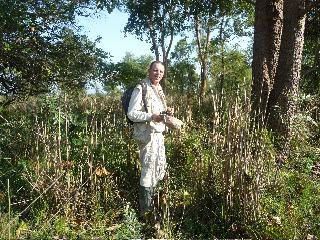
September 18, 2010
Sightings do persist of the Pink-Headed Duck (Rhodonessa caryophyllacea or Netta caryophyllacea). These almost mystic encounters have resulted in one famed 1991 book on the bird, Rory Nugent’s The Search for the Pink-Headed Duck.

In 2009, Richard Thorns (shown above) was in Kachin State in Myanmar looking for Pink-headed Duck. He felt he may have photographed the elusive duck (below).

© Richard Thorns, 2009. Used with permission.

© Richard Thorns, 2009. Used with permission.

© Richard Thorns, 2009. Used with permission.
On February 14, 2009, Richard Thorns and his guide were watching a local lake (part of what he called the HunterFarmer lake complex, N 24°23.074’ E 97°13.974’) when he saw a duck and photographed it.
Thorns is now returning there on Wednesday, September 22, 2010, because he wanted to go back to that same lagoon in the Bhamo region, where the farmer said he saw one of the birds in the past. In February 2010, water levels there were very low, but now on the tail end of the wet season, Thorns thinks the watering spot should be full of birds.
Also, Thorns was going to investigate Indawgyi Lake (as he has been refused permission to go to Kemaing, unfortunately). But having had a good look at the dimensions of Indawgyi lake, Thorns speculates it is simply too vast to show evidence as something as rare as the Pink-Headed Duck. Therefore, Thorns shall probably not go there, especially as the journey time is not extensive.
This is Richard Thorns’ new itinerary follows the Ayerawady river downstream to the following towns and villages (see these locations on Google Earth).:
Myitkyinam:
Talawgyi (stop I). Holding historical reports of Pink-Headed Duck in Burma. Note the meandering tributary, to the east of a huge oxbow just to the north of the town. Thorns plans to go east towards Highway 31, for a day or so.
Tahona: heavy forested village east of the Ayerawady. Stopping doubtful.
Sinbo (stop II). This is the best and likeliest stop. One can see a river tributary running southwest of the Ayerawady. This looks to be excellent habitat, with small river/marsh containing small pools (hopefully) and also bordered by thick forest – plus the ability to visit a small village in which to show the photographs to the locals!
Hkawngmye (no stop).
Chyingma (no stop)
Thamanggyi (no stop).
Bhamo: (stop III). This is where Thorns went last time, to 98 Ins (lakes), up the Tapin river. Here in February 2009, there was a report of possible Pink-Headed Duck by both a local farmer (who saw the bird on 2 occasions), and a traveling hunter. There was a large lagoon there, next to the farmer’s location, with a dwindling water level in February, but showing good birds especially egrets and ducks. Now after the rainy season Thorns expects there to be more activity.
Bhamo – Mandalay – Yangon – Bangkok.
Total maximum time allowed for journey down the Ayerawady: 25 days.

More significantly, there is a photograph of the pink-headed duck, before they were declared almost certainly extinct.

These birds were in Delacour’s collection, in Cleres, France. This black-and-white photograph was colorized for Frank Todd’s book Natural History of the Waterfowl California: Ibis Publishing, 1996. This was used from Kumar, et.al., Handbook on Indian Wetland Birds and Their Conservation, 2005.
It was always rare, and the last confirmed sighting was in 1935, although unconfirmed reports from India persisted until the early 1960s. In 1988, Rory Nugent, an American birder, and Shankar Barua of New Delhi, reported spotting the elusive bird on the banks of the Brahmaputra.
The last specimen was shot in 1935 in Darbhanga, Bihar, India, by C. M. Inglis, who did not even know what he had killed, till his dog, a retriever, brought the bird to him. The specimen later re-surfaced in the Government Museum in Madras in southern India, nearly 1000 miles away from where it had met its end. There it was on display at least until the 1980s.
One of the last captive pink-headed duck died in 1936 in Delacour’s collection, Cleres, France.
Sir David Ezra, a European living in what was then British India, kept some of these ducks in his aviary in Calcutta until 1945, and they were also kept in Clères, France, and Foxwarren Park, England earlier. Thus, captive flocks survived until at least 1945, but never bred for reasons unknown.

This historic illustration is from Hume and Marshall’s Game Birds of India, Burmah and Ceylon. Illustration does not show crested appearance of head.
Keep cryptozoology alive…
About Loren Coleman
Loren Coleman is one of the world’s leading cryptozoologists, some say “the” leading living cryptozoologist. Certainly, he is acknowledged as the current living American researcher and writer who has most popularized cryptozoology in the late 20th and early 21st centuries.
Starting his fieldwork and investigations in 1960, after traveling and trekking extensively in pursuit of cryptozoological mysteries, Coleman began writing to share his experiences in 1969. An honorary member of Ivan T. Sanderson’s Society for the Investigation of the Unexplained in the 1970s, Coleman has been bestowed with similar honorary memberships of the North Idaho College Cryptozoology Club in 1983, and in subsequent years, that of the British Columbia Scientific Cryptozoology Club, CryptoSafari International, and other international organizations. He was also a Life Member and Benefactor of the International Society of Cryptozoology (now-defunct).
Loren Coleman’s daily blog, as a member of the Cryptomundo Team, served as an ongoing avenue of communication for the ever-growing body of cryptozoo news from 2005 through 2013. He returned as an infrequent contributor beginning Halloween week of 2015.
Coleman is the founder in 2003, and current director of the International Cryptozoology Museum in Portland, Maine.
Filed under Avian Mysteries, Cryptomundo Exclusive, Cryptotourism, CryptoZoo News, Cryptozoologists, Expedition Reports, Extinct, Eyewitness Accounts, Men in Cryptozoology